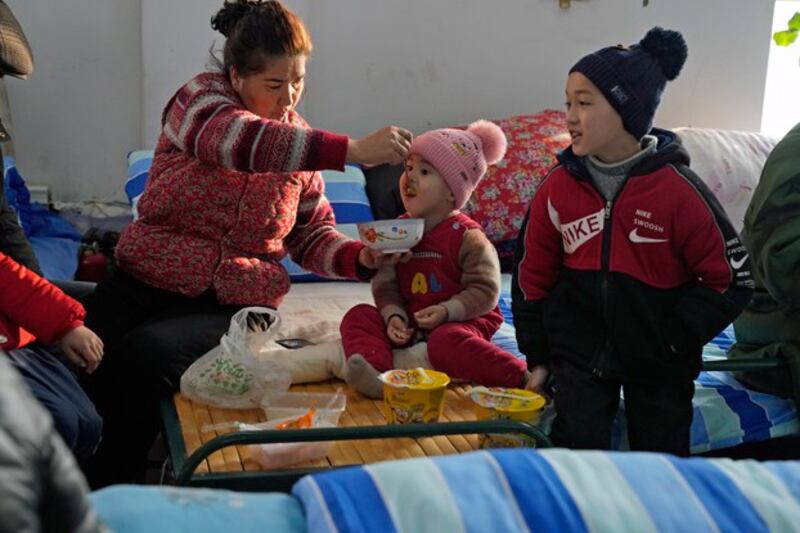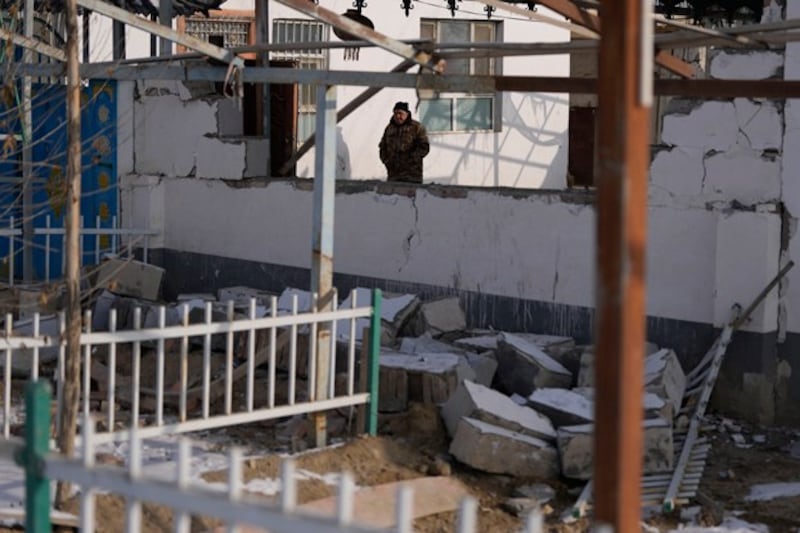A 7.1-magnitude earthquake that struck Xinjiang’s Uchturpan county, which borders Kyrgyzstan, early Tuesday killed three, injured five, and displaced more than 12,400 people living in the area, Chinese authorities and Akqi officials said.
Xinjiang emergency management authorities told Chinese state media at a press conference on Tuesday evening that the three who died in the quake, which struck at 2:09 a.m., were from Akqi county, just to the east of Uchturpan.
An Akqi country police officer later told Radio Free Asia that the three were ethnic Kyrgyz. An official at the Uchturpan County Civil Affairs Bureau confirmed the number of dead and injured people in Akqi.
Xinjiang is located along a seismic belt where earthquakes often occur. Emergency management authorities said the temblor did not result in a significant number of casualties in the thinly populated territory, though it affected a wide area.

The quake was reported as 7.1 magnitude by the China Geological Survey, but as 7 magnitude by the U.S. Geological Survey.
Another quake of the same magnitude in 1978 struck the area about 200 kilometers (124 miles) north of the latest epicenter in Uchturpan, called Wushi in Chinese, in Aksu prefecture.
The earthquake occurred approximately 29 kilometers (18 miles) northwest of Aksu’s Aykol village at a depth of about 13 kilometers (8 miles), according to the U.S. Geological Survey. Xinjiang emergency management authorities reported the epicenter to be in Yamansu village in Uchturpan.
Xinjiang emergency management authorities said that damage from the earthquake was limited. It reported that 49 houses were destroyed and 1,179 suffered some type of damage. The earthquake also damaged two bridges.
Officials said 12,426 residents had been displaced and 217 tents had been set up as temporary shelters.
Relief aid and aftershocks
Chinese media reported 1,104 aftershocks as of 8 a.m. local time Wednesday, more than 200 of which registered a magnitude of over 3, based on information from the China Earthquake Networks Center. The largest aftershock of 5.7 magnitude occurred about 22 kilometers (14 miles) from the quake’s epicenter.
Five villages lie within 20 kilometers (12 miles) of the epicenter. Local media reported that convulsions from the quake were strongly felt in Kashgar, Aksu, Ghulja and Urumqi in Xinjiang, as well as in Bishkek, Kyrgyzstan andAlmaty, Kazakhstan.
Radio Free Asia’s attempts to contact residents in the affected areas were unsuccessful because calling service was unavailable.

Amine Sedef, a Uyghur scholar who lives in Turkey and has relatives in Uchturpan, said Yamansu village, where many Kyrgyz people live, had extensive damage from the quake.
“Last night, upon hearing about the earthquake in Uchturpan, I grew increasingly worried about my family there,” she said. “Throughout the night and into the morning, I closely followed updates on Douyin and WeChat from individuals in Uchturpan. In a video I viewed last night, a cadre from Uchturpan mentioned that the entire Yamansu village had been destroyed and that the disaster was very severe there.”
Sedef said video footage of firefighters and rescue vehicles appeared to indicate a much more serious disaster than what the Chinese government reported.
“There were numerous hospital emergency vehicles and firetrucks, their sirens echoing throughout Uchturpan,” she said. “Watching the videos, one would naturally assume a severe disaster had occurred. There are many tents set up.”
The Chinese government has allocated 30 million yuan (US$4.23 million) to the region for disaster relief and emergency rescue work, including the relocation of residents affected by the quake, state media reported.
The amount of aid indicates the severity of the situation because China’s central government rarely gets involved in earthquake relief efforts in the Uyghur region, said Abdulhakim Idris, executive director of the Center for Uyghur Studies, a Washington D.C.- based think tank.
Information regulation
Uyghurs living in neighboring Kazakhstan said the quake had a severe impact on Almaty, the country’s largest city with an estimated population of 19.5 million people.
Qehriman Ghojamberdi, a Uyghur political analyst who lives in Almaty, said the quake registered a magnitude of 5 there.
“People in buildings rushed out to the streets, and on TV, it was advised not to enter buildings for the time being,” he said. “The impact was not limited to Almaty, as even Astana felt the tremors.”

Chinese authorities appear to be tightly controlling information about the earthquake, regulating the sharing of information and photos on social media platforms, and using state media to disseminate news about emergency rescue operations in the area.
Local media reported that the Aksu Provincial Network Management Office issued a notice warning citizens not to spread “false information” and “slanderous words” about the earthquake online, and threatening to hold those who do to account.
Xinjiang’s Public Prosecutor’s Office announced it issued civil penalties to individuals in six cases in Urumqi and other towns for allegedly posting “slanderous words” online.
The earthquake occurred as the U.N. Human Rights Council in Geneva, Switzerland, is reviewing China’s human rights record, with Beijing’s repression of Uyghurs and other Turkic minorities in Xinjiang a central focus.
Translated by RFA Uyghur. Edited by Roseanne Gerin and Jim Snyder.
